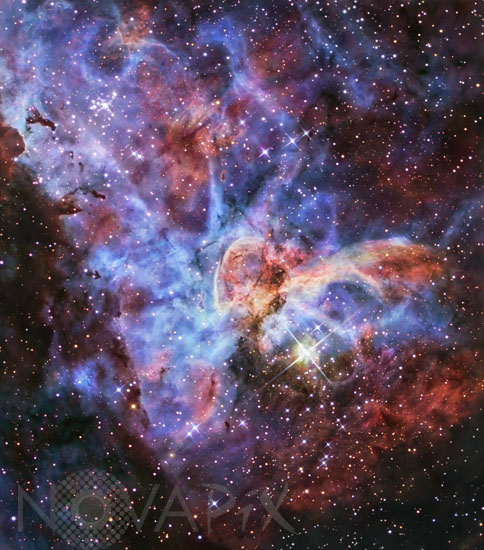Photo Agency - Astronomy - Space - Nature

NGC 3372 nebula and star Eta Carinae
auteur: R.Jay GaBany/Novapix
référence: a-neb33-72022
Image Size 300 DPI: 14 * 16 cm
Located at about 8000 light years within our home galaxy towards the southern constellation of Carina, the Great Nebula in Carina is one of the Milky Way's brightest and most prolific star forming regions. Here is the center area of the nebula; the bizarre structure near the center of this view is actually a cooler cloud of dust and bright filaments of hot, fluorescing gas that is partially silhouetted against a background of brighter, even more energized material. The bright star near the bottom of the image is the most massive nearby star, named Eta Carinae. Eta Carinae is over one hundred times more massive than our Sun and it's over a million times more brilliant. In fact, this star releases so much energy that its gravity can barely hold it together- the outward flow of radiation from its interior is unbelievably strong. Vast portions of its outer layers are being blown off into space forming an ever expanding wispy shroud in a slow, non-stop eruption of incredible violence. Stars like this are extremely rare- only a few dozen exist within any island universe. Because of their high luminosity, very large stars, like Eta, burn through their fuel rather quickly and end their lives as a super or hyper nova explosions that out-shine the combined light of all the stars in their host galaxy. Where the luminous life of a star like our Sun will span about ten billion years , super massive stars, like Eta Carinae, only shine for a few million, at most.
Two gigantic lobes of material expanding like giant balloons from the star are visible in this image.
This picture was obtained through 12.5 inch Ritchey-Chretien telescope and a SBIG STL-11000 camera between April and June 2007.
Several filters were used to produce this picture: red, green and blue captured the hues needed to reproduce the natural colors of the scene. Also used, a set of special astronomical filters that are tuned to limit the light reaching the camera to those wave lengths associated with the natural glow emitted by atoms of hydrogen, oxygen and sulfur which are abundant in most interstellar nebulae. Exaggerated blue hues indicates the presence of oxygen, red represents sulfur and turquoise reveals the signature of hydrogen atoms. As a side benefit, the sulfur filter was used to control the glare from the bright star Eta and resolve the surrounding lobes previously shown in the Hubble space telescope images.
Two gigantic lobes of material expanding like giant balloons from the star are visible in this image.
This picture was obtained through 12.5 inch Ritchey-Chretien telescope and a SBIG STL-11000 camera between April and June 2007.
Several filters were used to produce this picture: red, green and blue captured the hues needed to reproduce the natural colors of the scene. Also used, a set of special astronomical filters that are tuned to limit the light reaching the camera to those wave lengths associated with the natural glow emitted by atoms of hydrogen, oxygen and sulfur which are abundant in most interstellar nebulae. Exaggerated blue hues indicates the presence of oxygen, red represents sulfur and turquoise reveals the signature of hydrogen atoms. As a side benefit, the sulfur filter was used to control the glare from the bright star Eta and resolve the surrounding lobes previously shown in the Hubble space telescope images.
Contact : Stéphane Aubin +33-(0)9-51-26-53-76
© Novapix - All rights reserved






